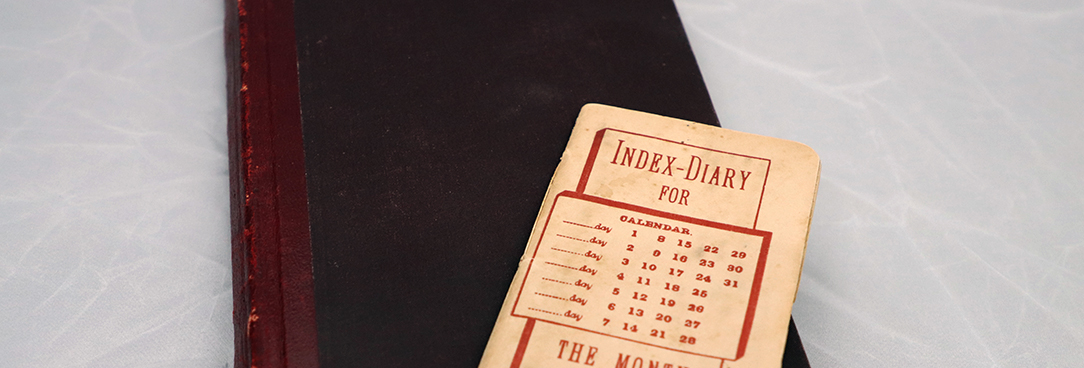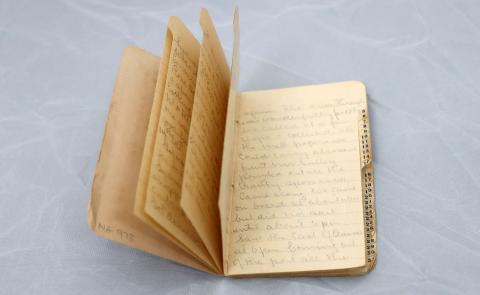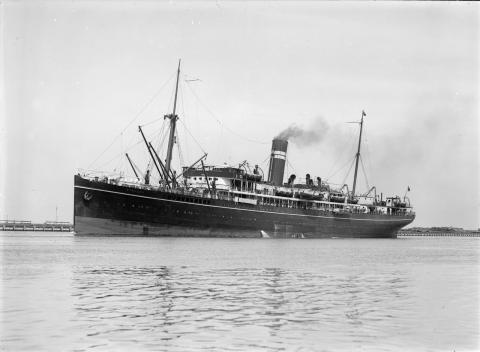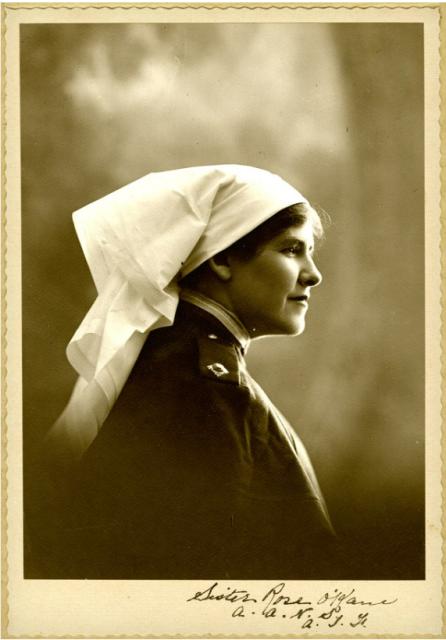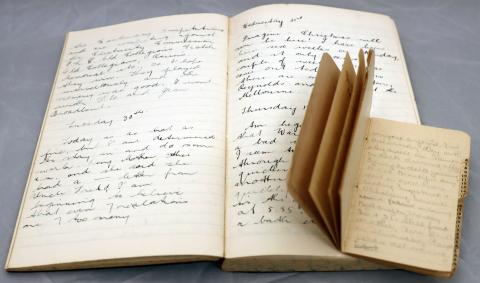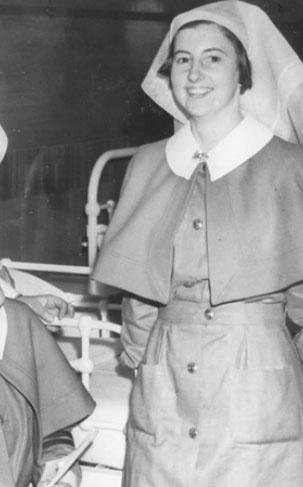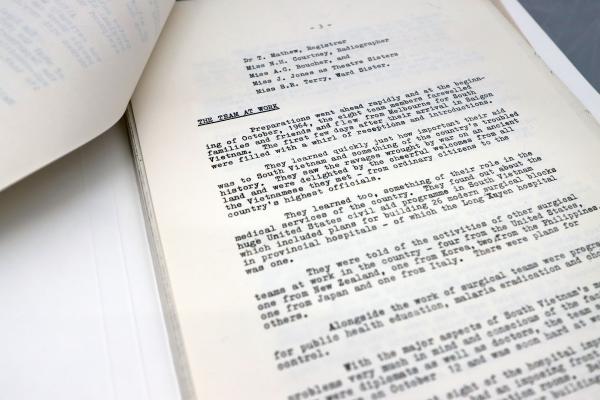
Author: Tara Oldfield
Senior Communications Advisor
New records added to the collection in the last month include records from the Royal Melbourne Hospital – making this the second record transfer of Royal Melbourne records to PROV in the last year. We add these to our extensive collection of health and welfare records for researchers to explore.
These records were all previously in the custody of the Royal Melbourne Hospital Archives and span the operational history of the hospital, from c. 1844 to 2020. There are also a small number of records created by Fairfield Hospital and North Western Health Care Network. The transfer includes administrative records, meeting minutes, correspondence, reports, manuals, and some patient records. Of particular interest are diaries of nurses Cone and Lawson, and reports of the surgical teams in Vietnam.
Please note the proceeding text describes records related to illness and death and may be upsetting for some readers.
Diary of Nurse Susie Cone
In 1918, many Australian soldiers returning from WWI had to be quarantined due to the Spanish flu. Nurse Cone was one of the military nurses on board the SS Wyreema which was on its way back to Australia. She, and many others from the ship, volunteered to work at a quarantine station in Western Australia upon their return. Fifteen of the twenty nurses who volunteered for the job of caring for soldiers in quarantine caught the Spanish flu and four died.
According to NAA records, Susie was a single 30-year-old woman from Melbourne at the time her diary was written. She was five foot two with a fair complexion, blue eyes and brown hair. Her NAA record is stamped with a Star, British war medal, and Victory medal.
Cone’s 1918 diary was no bigger than a playing card. Her neat handwriting was small in grey lead and spanned only 31 pages. Early pages describe the Wyreema.
“14th October. Got up at 6am rushed the bath. Went down Sydney did some shopping. Orders to embark at 1.30pm. Got down in taxis. Came aboard the Wyreema. Spent the afternoon exploring our new quarters. Edgecombe and I are in a cabin together. There are 46 sisters and a matron. Some hundreds of troops and officers on board. We drew out from the pier at about 4pm and anchored off Potts Point. I hear we are sailing at midnight.”
Cone describes the seasickness, weather, and activities on board including church services, reading and playing cards, as well as social dinners and concerts on the boat deck. She mentions Sister Rosa O’Kane taking a starring role in one of the plays on board.
Late November in the diary, Cone says “we are still undecided what we are going to do. The Government don’t seem to know what to do with us,” as Armistice had been declared by the time the ship reached Cape Town. They eventually returned to Australia, docking at Fremantle on 10 December 1918.
“Tuesday 10th. Got into the port at Fremantle at daylight. Got up early and when the pilot came off he told us that we could not have shore leave at about 9.20am. The shore authorities signalled for 20 sisters to nurse Spanish flu. Matron called for volunteers. 26 of us spoke up and then we drew lots for places. Brady and I were amongst the 20. We left the old Wyreema at 4pm on Tuesday and are all feeling very lonely. Sat on the jetty here at Wood Point while the people at the station finished a row they were having. Arrived up here hungry and tired. Unpacked and had a look around. Brady and I went down onto the jetty and gazed longingly out at the old boat wishing to heaven we were back there again.”
She describes the next day, preparing a ward with Nurses Wilkinson, Hamilton and Bradshaw in anticipation for the arrival of troops off the Boonah.
“Our tents and huts were soon full. Poor lads were in a terrible plight. With dirt all over them terribly sick, we had no drugs, no clean shirts or pyjamas to put on them. All we could do was wash them and get them as comfortable as possible. Three died the first day.”
The following days the troops were gravely ill. Cone called the place “hell” with more troops dying. By Saturday 14th she writes that O’Kane is off duty ill, with other nurses also feeling off colour. O’Kane deteriorates and more nurses fall ill as the days progress.
“Sat 21st Poor old O’Kane died early this morning, one can hardly realise that she has gone. Everybody very depressed about it. We gave her a military funeral today at 4pm. It’s sad to see how we old Wyreemians have decreased. Only nine of us on duty now.”
As the days went on, and more troops died, the nurses were ordered to stay away from the sick unless on duty. All Christmas festivities were off the table and tents moved further away from the wards. The diary ends, sadly and abruptly with the words “Tommy died”.
The diary described above as well as another one from 1919 were donated to the Royal Melbourne Hospital Archives by the family of Susie Cone and were preserved there until transfer to PROV.
You can now view digitised copies of the Cone diaries or order the physical records for viewing in our North Melbourne reading room.
Diary of Nursing Student Betty Constance Lawson
Betty Lawson was one of Australia’s most highly decorated nurses. Born in 1915 in Epping NSW, she trained as a nurse at the Royal Melbourne in 1934 with continued study in midwifery in 1937.
Her diary is dated 29.4.34. It’s a thick book handwritten in dark ink. It was written during her nurses training at the Royal Melbourne and, like Susie Cone’s diary, was donated to the Royal Melbourne Hospital Archives by the family.
The diary provides detailed accounts of what it was like to be a nurse in training in the 1930s.
“Monday 18th May. Our first day in the wards. What a day! I was made extra in ward 9, a female surgical ward. I rushed hither and tither madly all day and at night was so tired I could hardly stand up. Every bone and muscle of my body ached. My feet were like lobsters. That is not the worst however. What worried me more was the fact that almost everything I did or said seemed to be wrong. Still I got over it. Though for the first week I was very miserable and felt very sorry for myself.”
In following entries, she describes a Sister being unimpressed with her work, though she tries hard to do better. But by the 14th of July she says “Lyle told me as a secret that Dr Penington said I had improved.” Her days as a nurse are busy and she often feels bad to leave after a shift wondering how the remaining nurses will get through.
Entries about Lawson’s personal life are also scattered throughout the pages. She describes visiting her father’s grave, appointments, shopping trips and dances at the Town Hall.
Nurse Betty Lawson went on to sail the Wanganella bringing home wounded soldiers during WWII. She also worked in Repatriation Hospitals and attained Captain rank. After the war she held many senior nursing positions including 22 years at the Royal Melbourne. She received the Florence Nightingale Medal in 1967 and an MBE from the Queen in 1978.
You can now order Betty Lawson’s diary and view it in the North Melbourne reading room. You can find more information about Betty in the Royal Women's Hospital Biographical Compendium.
Reports of the Royal Melbourne Hospital Surgical Teams in Vietnam
The file marked “Reports from Australian surgical teams in Vietnam 1964-1970” begins with an 8-page document titled Project Long Xuyen.
“During 1964, the Australian Government decided to increase its non-military aid to South Vietnam. The decision followed requests from the South Vietnamese Government which were supported by the United States authorities. The Government felt that one way in which a substantial contribution could be made to the welfare of the Vietnamese was through direct medical aid.”
A team was put together by October 1964 to attend a French built hospital in Long Xuyen. The first team to arrive was comprised of a team leader, second surgeon, anaesthetist, registrar, radiographer, two theatre sisters and one ward sister.
“Their first sight of the hospital impressed them. The series of buildings had an imposing front of administrative offices, pharmacy and examination rooms. Behind this was a large square where wards and other buildings were neatly spaced – and freshly painted. Inside the hospital, the impression was not so favourable.”
The document describes how the team overcame a lack of appropriate beds and language barriers.
“The theatres were constantly busy with a wide range of operations. About 20 percent were for bodily injuries and most of them were the result of gunshot or grenade wounds.”
The team assisted with the implementation of a blood bank among other initiatives to service the growing needs of the area. They praised the existing staff. The hospital’s senior administrator and physician, Dr Thinh, was described as sparing no effort to help make the venture a success. Surgeon Dr Ban was devoted to solving the hospital’s surgical problems. Obstetrician and gynaecologist Dr Nhi saw up to 160 patients a day.
The document continues on with details of the program’s success.
Unfortunately, other papers in the file do not paint quite such a pretty picture. A letter from one of the doctors who visited Vietnam in 1970 says that while the team is functioning quite well, a lack of punctuality and zeal is slowly creeping in. He goes onto complain about a paediatrician who was “totally unsatisfactory. He was a chronic alcoholic and possibly depressed as well. He functioned poorly and was an embarrassment on many occasions.” When warnings didn’t improve the man’s work ethic, he was shipped back to Melbourne. He described another three unsatisfactory paediatricians who spent time there before explaining the pull out of the full paediatric team. He said it was badly done and not well communicated to the people at Long Xuyen. But he seemed more optimistic about the rest of the medical team still in place.
“The calibre of the people coming up here is important.”
Other documents in the file include reports from Professor Sunderland, reports from the surgical team and reports from the team leader.
You can order this surgical teams file and view in the North Melbourne reading room.
The full list of newly transferred records is below:
Records in the previous Royal Melbourne Hospital transfer were listed in the December blog post, with a recent Bendigo health transfer listed in January.
Visit the Royal Melbourne Hospital agency page to see everything in our collection from the hospital.
Material in the Public Record Office Victoria archival collection contains words and descriptions that reflect attitudes and government policies at different times which may be insensitive and upsetting
Aboriginal and Torres Strait Islander Peoples should be aware the collection and website may contain images, voices and names of deceased persons.
PROV provides advice to researchers wishing to access, publish or re-use records about Aboriginal Peoples
